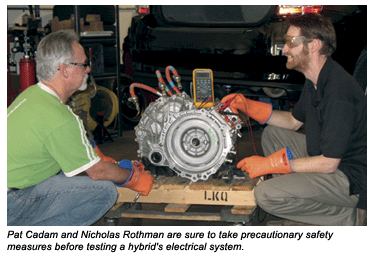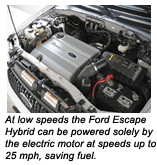As the price of gasoline goes up, so does the demand for fuel-efficient hybrid vehicles. Currently, there are about 1.1 million hybrid vehicles on the road. Within five years, hybrids are expected to account for 20 to 25% of all new car and light-truck sales. So sooner or later, you’ll be tooling up to work on these vehicles.

One item you will have to get is a high-voltage digital voltmeter. The unit should be able to read up to 600 volts AC/DC, or up to 1,000V AC/DC would be even better. Depending on the make, model and year of the hybrid, the battery pack may be rated from 144V (Honda Insight or Civic) up to 330V (Ford Escape). The power inverter on some hybrids can bump up the voltage even higher, to 500V or more. So you need a voltmeter that can read these higher voltages.
Another item that is absolutely essential is one or more pairs of insulated rubber gloves that are rated Class 0 to provide shock protection up to 1,000V AC/DC. Gloves rated at Class 00 provide protection to 500V AC and 750V DC, but may not provide the extra margin of safety that gloves rated to Class 0 can provide. Watch out for cheap imported gloves that may claim to meet these safety standards, but are too thin to provide adequate protection.
Insulated gloves can be a lifesaver, literally, if you happen to touch a live high-voltage circuit in a hybrid. Most of the high-voltage cables are color-coded orange to warn you of their potential danger. Even so, there may be other high-voltage components, such as capacitors in the power inverter, that are not color-coded.
Gloves should always be worn when working around any high-voltage components on a hybrid, including the battery, power inverter or high-voltage cables.
The procedure for isolating the hybrid battery varies depending on the vehicle, but typically involves flipping a switch on the hybrid battery pack or disconnecting a battery cable or fuse. On a first generation Toyota Prius, the hybrid battery is disconnected by opening the trunk, removing the liner from the left front corner, and pulling straight back on a small orange handle to remove the battery connection plug.
 Once the high-voltage battery has been disconnected and isolated from the vehicle’s electrical system, the rubber gloves can be taken off. But the insulated gloves should always be worn as an added safety measure when pulling or flipping the battery power disconnect switch on a hybrid. Always treat the high-voltage power systems on these vehicles with respect because the shock that a high-voltage direct current produces can be deadly.
Once the high-voltage battery has been disconnected and isolated from the vehicle’s electrical system, the rubber gloves can be taken off. But the insulated gloves should always be worn as an added safety measure when pulling or flipping the battery power disconnect switch on a hybrid. Always treat the high-voltage power systems on these vehicles with respect because the shock that a high-voltage direct current produces can be deadly.
What about a high-voltage charger for the battery pack? None should be needed. The battery charge is maintained by the charging system when the engine is running. The “auxiliary” 12V battery on a hybrid that operates the lights and 12V accessories should be charged with a “smart” charger and not a conventional 12V battery charger. If the high-voltage battery goes down for some reason, it either means there is something wrong with the hybrid charging and control system, or the battery itself has failed. Hybrid batteries are proving to be very durable, and most are covered by an extended warranty. Toyota currently covers their hybrid battery and other major hybrid components for eight years or 100,000 miles.
Toyota does make a special “Digital Battery System Analyzer” (00002-V8150-KIT) for diagnosing the battery pack on a Prius or other Toyota or Lexus hybrid.
For diagnostic work, nothing beats an OEM factory scan tool. A factory scan tool with current software can access and display every PID that has been included in a vehicle, along with all of the factory self-tests. The factory scan tool can also be used to flash reprogram the PCM if a software update is necessary to solve a particular driveability or emissions problem.
A high-end, professional-grade aftermarket scan tool with the latest software can also be used for diagnosis, but there have been issues with how well some aftermarket scan tools work on late-model hybrids. Some scan tools may provide only limited data, others may provide no data at all, or worse yet, totally incorrect data!
Part of the problem is that some vehicle manufacturers have been slow to release their latest diagnostic information to aftermarket scan tool manufacturers, or the information that has been released is not complete. And even when information is made available, it takes time to sort, reformat and incorporate the latest changes into a scan tool software update.
We asked Craig Van Batenburg, a hybrid trainer (www.auto-careers.org) what scan tool he uses for diagnostic work on Toyota hybrids. He said he uses a Mastertech scan tool. We also spoke to Pat Cadam (www.patsgarage.com) who runs an independent repair shop in San Francisco, and specializes in hybrid service work. (He and Nicholas Rothman are featured in these photos and on the cover. They are partners in Green Gears, a business that deals with the sales and installation of PHEV conversion units. You can see what else they are up to at www.greengears.net and at http://greengearhead.blogspot.com.) Cadam said he also uses a Mastertech scan tool on both Toyota and Honda. He also emphasized the importance of keeping his scan tool up-to-date with the latest software updates.
Another essential “tool” for working on hybrids today is information. This includes diagnostic information, diagnostic codes, technical service bulletins, service and repair procedures, wiring diagrams, recalls, you-name-it. The best place to find this kind of information is on the vehicle manufacturer’s own technical website. Toyota’s website is techinfo.toyota.com. Honda’s website is www.serviceexpress.honda.com. A complete listing of OEM technical websites can be found at www.nastf.org.
Most of the OEM technical websites require you to pay an access fee that ranges from $20 to $30 for a “short term” (one- to three-day) subscription. Longer monthly and even yearly subscriptions are also available for heavy users, but can be rather pricey ($200 to $300 a month, or up to $1,500 a year or more depending on the auto manufacturer). A less expensive alternative is to subscribe to an aftermarket information service. The advantage with these services is that one subscription fee covers all makes and models. Once you become familiar with how the menus are arranged and where to find the information you are looking for, these websites are often much faster and easier to use than the OEM websites (all of which are organized differently and take some time to learn).
Something else that cannot be overlooked is the need for hybrid training. Hybrid components are very complex and require a thorough understanding of the entire system and how it all works. If your technicians have not attended a hybrid clinic or taken any online hybrid self-study courses, the sooner they can do so the better. Hybrid training is available from a variety of sources, including the NAPA Institute of Automotive Technology. Van Batenburg offers training clinics all over the U.S. throughout the year, as does Jack Rosebro (e-mail [email protected] or call 310-801-7818).
Except for the items we’ve already mentioned, hybrids don’t require any special tools. Most well-equipped repair shops should have no trouble doing routine maintenance, brake work and other conventional repairs on hybrid vehicles. A hybrid vehicle is essentially the same as any other vehicle, except for the high-voltage battery pack, hybrid drivetrain and control electronics.

